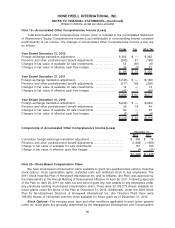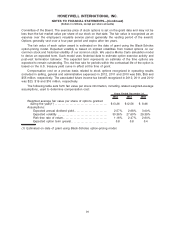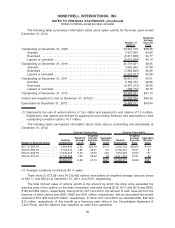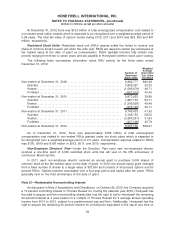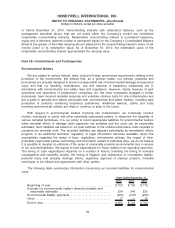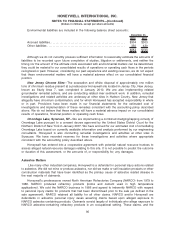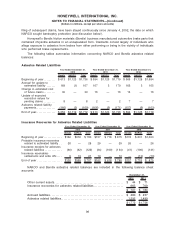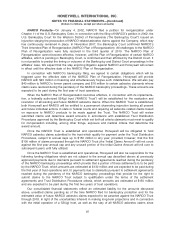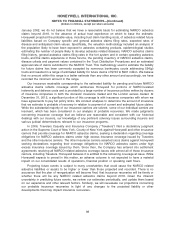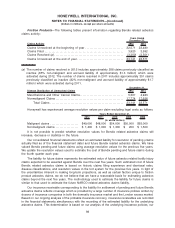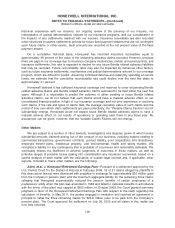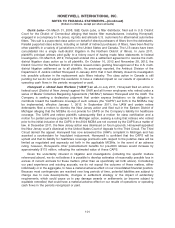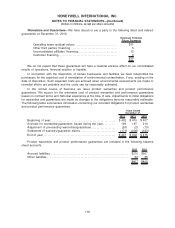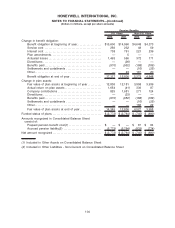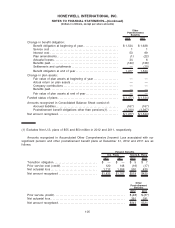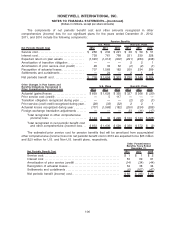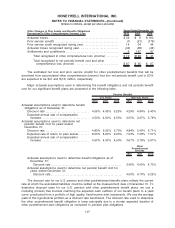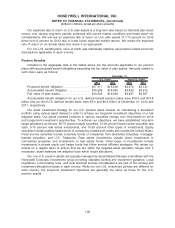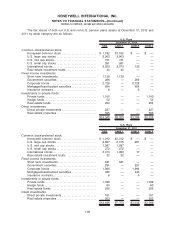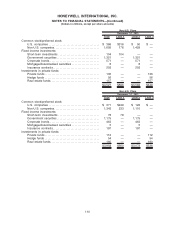Honeywell 2012 Annual Report Download - page 109
Download and view the complete annual report
Please find page 109 of the 2012 Honeywell annual report below. You can navigate through the pages in the report by either clicking on the pages listed below, or by using the keyword search tool below to find specific information within the annual report.historical experience with our insurers, our ongoing review of the solvency of our insurers, our
interpretation of judicial determinations relevant to our insurance programs, and our consideration of
the impacts of any settlements reached with our insurers. Insurance receivables are also recorded
when structured insurance settlements provide for future fixed payment streams that are not contingent
upon future claims or other events. Such amounts are recorded at the net present value of the fixed
payment stream.
On a cumulative historical basis, Honeywell has recorded insurance receivables equal to
approximately 38 percent of the value of the underlying asbestos claims recorded. However, because
there are gaps in our coverage due to insurance company insolvencies, certain uninsured periods, and
insurance settlements, this rate is expected to decline for any future Bendix related asbestos liabilities
that may be recorded. Future recoverability rates may also be impacted by numerous other factors,
such as future insurance settlements, insolvencies and judicial determinations relevant to our coverage
program, which are difficult to predict. Assuming continued defense and indemnity spending at current
levels, we estimate that the cumulative recoverability rate could decline over the next five years to
approximately 31 percent.
Honeywell believes it has sufficient insurance coverage and reserves to cover all pending Bendix
related asbestos claims and Bendix related asbestos claims estimated to be filed within the next five
years. Although it is impossible to predict the outcome of either pending or future Bendix related
asbestos claims, we do not believe that such claims would have a material adverse effect on our
consolidated financial position in light of our insurance coverage and our prior experience in resolving
such claims. If the rate and types of claims filed, the average resolution value of such claims and the
period of time over which claim settlements are paid (collectively, the “Variable Claims Factors”) do not
substantially change, Honeywell would not expect future Bendix related asbestos claims to have a
material adverse effect on our results of operations or operating cash flows in any fiscal year. No
assurances can be given, however, that the Variable Claims Factors will not change.
Other Matters
We are subject to a number of other lawsuits, investigations and disputes (some of which involve
substantial amounts claimed) arising out of the conduct of our business, including matters relating to
commercial transactions, government contracts, product liability, prior acquisitions and divestitures,
employee benefit plans, intellectual property, and environmental, health and safety matters. We
recognize a liability for any contingency that is probable of occurrence and reasonably estimable. We
continually assess the likelihood of adverse judgments of outcomes in these matters, as well as
potential ranges of possible losses (taking into consideration any insurance recoveries), based on a
careful analysis of each matter with the assistance of outside legal counsel and, if applicable, other
experts. Included in these other matters are the following:
Allen, et al. v. Honeywell Retirement Earnings Plan—Pursuant to a settlement approved by the
U.S. District Court for the District of Arizona in February 2008, 18 of 21 claims alleged by plaintiffs in
this class action lawsuit were dismissed with prejudice in exchange for approximately $35 million (paid
from the Company’s pension plan) and the maximum aggregate liability for the remaining three claims
(alleging that Honeywell impermissibly reduced the pension benefits of certain employees of a
predecessor entity when the plan was amended in 1983 and failed to calculate benefits in accordance
with the terms of the plan) was capped at $500 million. In October 2009, the Court granted summary
judgment in favor of the Honeywell Retirement Earnings Plan with respect to the claim regarding the
calculation of benefits. In May 2011, the parties engaged in mediation and reached an agreement in
principle to settle the three remaining claims for $23.8 million (also to be paid from the Company’s
pension plan). The Court approved the settlement on July 20, 2012 and all claims in this matter are
now fully resolved.
100
HONEYWELL INTERNATIONAL INC.
NOTES TO FINANCIAL STATEMENTS—(Continued)
(Dollars in millions, except per share amounts)


